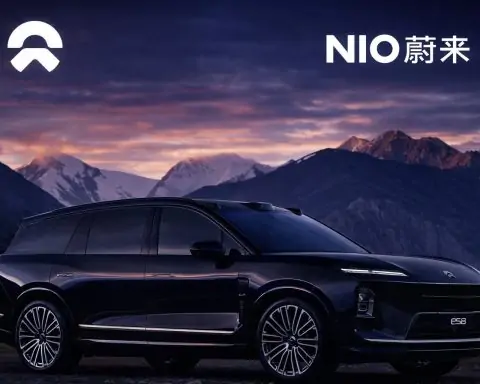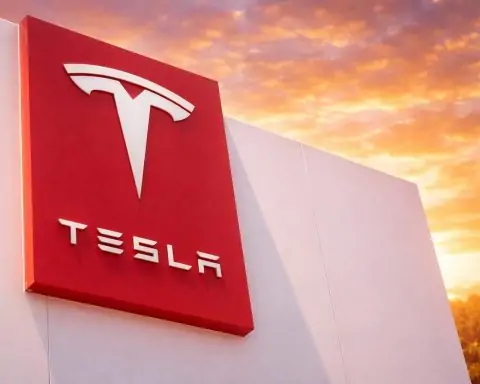- Google unveiled its Pixel 10 lineup in New York, with the base Pixel 10 at $799 and the Pixel 10 Pro at $1,799, adding a telephoto camera to the base model.
- The U.S. government announced a 9.9% equity stake in Intel worth about $8.9–$10 billion by converting CHIPS Act subsidies into stock.
- SpaceX launched CRS-33 to the ISS on Aug 24, 2025, from Cape Canaveral at 2:45 AM ET; the Falcon 9 booster landed on a drone ship for its 7th reuse and the Dragon capsule docked on Aug 25, as SpaceX reached 100 launches in 2025 by mid-August.
- NASA unveiled a 3D-printed Mars habitat in Houston for four volunteers to live a 12-month mock mission later this year, built with industrial 3D printers to mimic Red Planet conditions.
- Lamborghini scrapped plans for a near-term fully electric hypercar, but unveiled the Fenomeno hybrid for $3.5 million with a V12 engine, and all 30 units sold out.
- In April 2025 the UK quietly introduced flexibilities to the Zero Emission Vehicle mandate, allowing manufacturers to continue selling petrol and hybrid models into late this decade without penalties.
- DaVita disclosed a July ransomware attack exposing data for 2.7 million patients, and has spent about $13.5 million on incident response and recovery.
- Spotify will raise Premium Individual prices starting in September 2025, from €10.99 to €11.99, as it grows to 551 million monthly listeners and 220 million paid subscribers.
- Telefónica will begin testing direct satellite connectivity to standard smartphones in remote Europe later in 2025 using low Earth orbit satellites.
- TSMC confirmed a $100 billion expansion of its Arizona chip facilities, in addition to the $65 billion already committed.
Over August 25–26, 2025, a wave of global tech news (beyond the AI buzz) made headlines – from surprising smartphone launches and semiconductor shake-ups to breakthroughs in space, green tech, cybersecurity, telecom, robotics, and biotech. Below is a comprehensive roundup of the top developments by sector, with key facts, context, and expert insights.
Consumer Electronics – New Phones and Steady Prices
Google Unveils Pixel 10 Lineup: Google introduced its latest Pixel 10 smartphones at a New York event, showing off smarter features but relatively modest hardware changes [1] [2]. Notably, Google held the line on pricing despite supply chain and tariff concerns – the base Pixel 10 now starts at $799, while a new foldable Pixel 10 Pro is priced at $1,799, unchanged from last year [3] [4]. The base model even gains a telephoto camera, a feature previously reserved for higher-end Pixels [5]. Tech analysts noted the emphasis was on software and user experience over specs this year. “This feels more like a big push from a marketing perspective,” observed Carolina Milanesi of Creative Strategies, contrasting the incremental Pixel 10 upgrades with 2024’s bold hardware refresh [6]. With Apple’s next iPhones expected in the fall, Google appears to be betting that refined software and aggressive marketing can broaden Pixel’s appeal without raising prices.
Samsung & Others: (No major Samsung flagship launch occurred on these days, as their foldables debuted earlier in the summer.) However, industry chatter focused on upcoming fall releases – e.g. Apple’s iPhone 16 series – and the broader smartphone market. Recent data showed foreign-branded phone sales in China slumping over 30% year-on-year [7], underscoring headwinds for Western brands in Asia. Meanwhile, component makers at IMID 2025 tech expo teased next-gen display and battery tech for holiday-season gadgets [8]. Overall, the consumer electronics news cycle was relatively calm ahead of September’s expected product reveals, making Google’s Pixel event the week’s standout in gadgets.
Semiconductors – U.S. Stakes a Claim & Industry Shifts
U.S. Buys 9.9% of Intel: In an unprecedented move, the U.S. government announced it will take a 9.9% equity stake in chip giant Intel – roughly $8.9–10 billion worth of shares – by converting federal semiconductor grants into stock [9] [10]. President Donald Trump framed the deal as a win for taxpayers: the funds, originally CHIPS Act subsidies to help Intel build U.S. factories, are now an investment. “He walked in wanting to keep his job and he ended up giving us $10 billion,” Trump quipped about Intel’s CEO, touting that “we picked up $10 billion” for the American public [11]. Commerce Secretary Howard Lutnick explained the new approach bluntly: “If we’re going to give you the money, we want a piece of the action for the American taxpayer” [12]. This marks a sharp policy shift – prior administrations offered chip subsidies as non-recourse grants, but now Washington is demanding ownership stakes to ensure returns [13]. The Intel investment, aimed at bolstering its foundry (contract manufacturing) business, stunned industry watchers and raised questions about government influence in tech firms [14] [15]. Intel’s stock initially ticked up on the news, but the company later cautioned that having Uncle Sam as a major shareholder could pose risks – potentially complicating foreign sales or future subsidies due to regulatory concerns [16] [17].
No Equity Grab at TSMC or Micron: U.S. officials moved quickly to clarify that this equity-for-subsidies model won’t be applied broadly to all chipmakers [18] [19]. A White House spokesperson confirmed there are no plans to seek stakes in Taiwan’s TSMC or memory maker Micron, which are already investing heavily in American fabs [20]. (TSMC, for example, just confirmed a colossal $100 billion expansion of its Arizona chip facilities, on top of $65B previously committed [21].) In fact, reports say TSMC’s executives had quietly warned they might return U.S. subsidies rather than surrender equity [22]. By exempting such foreign and healthy firms, the administration seems keen not to scare off global chip investment. Still, the bold Intel deal has global rivals and governments watching closely. “The era of giving ‘free money’ to chip companies is over,” noted one industry analyst – now subsidies may come with strings (and shareholders) attached. The coming months will reveal whether Intel’s infusion spurs a turnaround – and whether other countries emulate America’s activist approach in their own semiconductor sectors [23] [24].
Chip Industry Tidbits: In other chip news, SoftBank’s Arm unit IPO prep and Nvidia’s surging valuation (on AI chip demand) stayed in focus, but AI developments are beyond our scope here. Meanwhile, global semiconductor sales showed signs of rebounding from the 2023 downturn, according to the latest WSTS report, and supply chain adjustments (like more chip assembly in India and Vietnam) continued as the U.S.-China tech rift deepened. All told, the period saw an historic government intervention with Intel, even as market forces and geopolitics keep reshaping the semiconductor landscape.
Space Technology – Launch Milestones and Mars Simulations
SpaceX’s Busy Weekend:SpaceX capped a frenetic schedule with a pre-dawn launch on Sunday, Aug. 24, delivering over 5,000 lbs of supplies and experiments to the International Space Station [25]. The Falcon 9 rocket blasted off right on time at 2:45 AM ET from Cape Canaveral and successfully landed its first-stage booster on a drone ship minutes later – the booster’s 7th reuse [26]. This mission (CRS-33) was SpaceX’s 33rd ISS resupply flight, and the Dragon cargo capsule docked with the ISS on Monday morning, Aug. 25 [27]. Notably, SpaceX is launching at an unprecedented pace: it logged 100 launches in 2025 by mid-August, far ahead of last year’s tempo [28]. “Falcon launch #100 of 2025. For reference… we hit 100 on Oct. 20 in 2024,” SpaceX’s Bill “Kiko” Dontchev noted, underscoring the company’s record-breaking cadence [29]. Much of that volume comes from Starlink deployments, making SpaceX the most prolific launcher globally this year [30].
Starship Test Scrubs (Again): All eyes were also on SpaceX’s Starship, the next-generation mega-rocket slated for deep space. Elon Musk’s team attempted a long-awaited Starship Flight 10 test on Sunday evening (Aug. 24) in Texas – but a last-minute “ground systems issue” caused a scrub about 30 minutes before liftoff [31]. The launch was re-targeted for Monday Aug. 25, then scrubbed again due to the technical glitch (per SpaceX updates) [32]. This flight would be the fourth Starship test of 2025, and SpaceX is eager to finally get a fully successful one under its belt after the last three ended in mid-air explosions or pad mishaps [33]. The stakes are high: NASA is counting on Starship to land astronauts on the Moon in 2027, and SpaceX needs it for Mars ambitions [34]. Each delay puts pressure on the program, but engineers remain optimistic. SpaceX will likely try again within days once the issue is resolved, as crowds of space fans live-stream each attempt, hoping to see Starship stick its first landing.
NASA’s Martian Habitat Simulation: While SpaceX reaches for orbit, NASA is simulating Mars on Earth. Over the weekend, NASA unveiled a 3D-printed Mars habitat in Houston that will soon host volunteers for a year-long mock Mars mission [35]. The facility, part of the CHAPEA program (Crew Health and Performance Exploration Analog), is an enclosed habitat built with industrial 3D printers to mimic Red Planet conditions [36]. Reporters visiting on Aug. 22 saw the habitat’s tight living quarters where four volunteers will begin living later this year – eating, sleeping, and working as “Martians” for 12 months. They’ll even perform simulated spacewalks and face resource limits to test crews’ physical and mental endurance for long-duration missions [37]. Insights from this experiment will help NASA design life-support systems and protocols for real Mars missions in the 2030s. As one NASA engineer quipped, “We’re going to learn a lot about living on Mars – without leaving Texas.” [38]. The habitat’s construction techniques (3D printing with analog Martian soil) could even be used on Mars in the future to build bases using local materials [39]. From orbital launches to Martian campouts, the past 48 hours highlighted how both the private sector and NASA are pushing boldly toward the cosmos.
Green Tech & Automotive – EV Turbulence and Policy Pushback
Lamborghini Pumps the Brakes on EVs: In a candid moment, the head of luxury automaker Lamborghini declared that his elite customers aren’t ready for an all-electric supercar. CEO Stephan Winkelmann revealed the company has scrapped plans for a fully electric model in the near term, responding to purist clientele who still crave roaring engines [40] [41]. “We could do a very powerful, very fast fully electric car, but it’s not about what we are able to do – it’s about fulfilling the dreams of customers. The customers want internal combustion engines,” Winkelmann told ABC News [42]. This marks a striking stance in 2025, as most automakers race toward EVs. Lamborghini isn’t abandoning electrification entirely – it just unveiled the Fenomeno, a $3.5 million hybrid hypercar with a V12 engine (all 30 units sold out instantly), and its upcoming Urus SUV will be a plug-in hybrid [43] [44]. But for now, Lamborghini will keep offering throaty V8s and V12s as long as regulations allow. Winkelmann noted that overall “acceptance of electric cars is flattening… [and] even more true for supercars”, so the brand will hold off on a pure EV until buyers (or laws) demand it [45]. The revelation underscores a broader theme: even as EV sales grow in mainstream segments, at the ultra-luxury end some enthusiasts are pushing back, unconvinced that silent battery power can match the visceral thrill of gasoline engines.
UK Eases Electric Vehicle Mandate: A similar pump of the brakes occurred in UK policy. Documents leaked over the weekend showed that major automakers – BMW, Jaguar Land Rover, Toyota, and Nissan – successfully lobbied the British government to water down upcoming EV sales rules [46] [47]. The UK’s previous Zero Emission Vehicle (ZEV) mandate would have forced carmakers to sell an ever-rising percentage of EVs each year or face steep fines. Carmakers argued the targets (set by the prior administration) were unrealistically high – “much more radical than equivalent rules in the EU or California” – and warned sticking to them would “materially damage [their] ability to invest” in UK factories and cost thousands of jobs [48] [49]. In response, the current government quietly introduced “flexibilities” in April, effectively relaxing the mandate’s requirements (a fact only now coming to light) [50] [51]. The revised rules give manufacturers more leeway to continue selling petrol and hybrid models into late this decade without incurring penalties [52]. Green groups have criticized the rollback, noting the UK risks falling behind its climate goals, but industry cheered the move. The episode reveals the ongoing tug-of-war between environmental targets and economic/consumer realities. It seems even policymakers are acknowledging that the road to an EV-only future may need more gradual on-ramps.
Climate Tech Odds and Ends: Elsewhere in clean tech, renewable energy milestones continued quietly: Europe’s largest battery storage system (in the UK) went live to help balance wind power, and China reported record solar panel exports amid booming global demand [53]. In the U.S., the Department of Energy announced new funding for direct air carbon capture projects, reflecting the growing investment in climate tech innovation. While these didn’t grab front-page headlines, they underscore steady progress in the green technology transition even as the transportation sector wrestles with its electric pivot.
Cybersecurity & Privacy – Regulator Warnings and a Massive Health Breach
FTC to Tech Companies: Don’t Censor or Backdoor for Foreign Laws: U.S. regulators issued a sharp rebuke to Big Tech over user privacy and free speech. Federal Trade Commission (FTC) Chair Andrew Ferguson published an open letter to large tech platforms on Aug. 22, essentially warning them not to bend to foreign governments’ rules if it means eroding Americans’ rights [54] [55]. This comes as Europe’s Digital Services Act (DSA) and the UK’s Online Safety bill impose new content moderation and encryption requirements that clash with U.S. First Amendment norms. Ferguson’s letter, sent to companies from Apple and Meta to X (Twitter) and Cloudflare, stated that complying with foreign censorship demands or building encryption backdoors “could violate U.S. law.” [56] He cautioned firms not to over-censor content or weaken security for American users under the guise of following overseas laws. “American consumers do not reasonably expect to be censored to appease a foreign power,” Ferguson wrote, adding that such moves may deceive users and invite FTC action [57]. The Biden (Trump) administration has recently been vocal in opposing Europe’s aggressive tech regulations – even reportedly instructing U.S. diplomats to complain about the DSA’s impact [58]. The FTC letter puts companies on notice that Washington expects them to prioritize U.S. privacy and speech standards, even as they operate globally. It’s a notable transatlantic tensions flare-up: while EU regulators push Big Tech to do more on content and data, U.S. officials are effectively telling them not to over-compliance in ways that hurt Americans’ protections.
Ransomware Breach Hits Millions of Patients: In the latest reminder of cyber threats, a major healthcare data breach was disclosed that affects 2.7 million people. Dialysis provider DaVita – which runs nearly 3,000 clinics – confirmed that a ransomware attack in July infiltrated a database containing sensitive patient information [59] [60]. Hackers gained access to one of DaVita’s laboratory systems and encrypted parts of the network. While DaVita first acknowledged a cyber “incident” back in April, only now has the scale become clear via a government breach portal filing: 2,700,000 individuals’ data were exposed [61]. The stolen info reportedly includes patient names, contact info, and medical data – a trove for identity thieves. DaVita says it managed to keep dialysis treatments running by switching to backup processes during the IT outage, avoiding harm to patients’ health [62] [63]. The company has begun notifying current and former patients and is offering free credit monitoring to mitigate fallout [64]. The cleanup has been costly: DaVita spent about $13.5 million so far on incident response, system restoration, and bolstering security [65]. Cybersecurity experts note this is one of the largest healthcare breaches of 2025 and part of a surge of attacks on hospitals and providers. They urge healthcare organizations to harden defenses as ransomware gangs grow more brazen. The DaVita attack – ranked the 4th-largest health data breach this year – underscores that critical infrastructure remains in hackers’ crosshairs, and the consequences for privacy and trust are severe [66].
Other Cyber Highlights: Also of note, Nevada’s state government had to shut down offices due to a “wide-ranging network security incident” (suspected cyberattack) [67], illustrating that public sector targets are under strain too. And in international cybercrime news, Nigeria deported 50 foreign nationals (including many Chinese) as part of a crackdown on online fraud rings [68]. Meanwhile, several high-profile vulnerabilities were disclosed and patched in popular software, keeping IT teams busy with updates. All told, it was a week where cybersecurity made headlines both for regulator action and costly criminal attacks.
Telecom & Media – Spotify’s Price Hike and Subscriber Ambitions
Spotify Plans Price Rises with New Features: Music streaming giant Spotify signaled it will be raising subscription prices in many markets as it pushes toward an audacious goal: 1 billion users. In an interview with the Financial Times, co-president Alex Norström said Spotify is introducing new services and will “do price increases… when it makes sense” as part of its growth strategy [69]. Concretely, starting in September the company’s Premium individual plan will go up by 1 euro – from €10.99 to €11.99 – across dozens of regions including Europe, Asia, Latin America, the Middle East, and Africa [70]. Similar ~$1 equivalent hikes are expected in the U.S. and elsewhere (some markets saw increases earlier in August). Norström framed the uptick as a natural evolution: “Price increases and adjustments… that’s part of our business toolbox and we’ll do it when it makes sense,” he told FT [71]. He emphasized the added revenue will fund new features and content to keep users hooked. Industry insiders speculate upcoming Spotify offerings could include enhanced podcast and audiobook integrations, hi-fi audio tiers, or AI-driven personalization (Spotify is careful not to mention AI, but analysts read between the lines).
Importantly, Spotify has newfound pricing power after years of prioritizing growth over profit. The Swedish company posted its first-ever annual profit last year, thanks to a combination of earlier price increases and cost-cutting measures [72]. Investors reacted positively to the latest hikes, viewing them as a sign of maturing business economics [73] [74]. Spotify’s user base is still expanding – it reported 551 million monthly listeners (and 220M paid subscribers) last quarter – but growth is slowing in saturated markets. Hence the dual strategy: expand into new markets (India, Africa, etc.) and extract more revenue per user via premium upsells. So far, so good: there’s little evidence of mass cancellations after recent price bumps, suggesting Spotify may successfully boost margins. The coming rollout of new features will test whether users feel they’re getting extra value for the extra cost.
Telecom Roundup: On the pure telecom side, it was a relatively quiet 48 hours. One notable development: Kuwait announced the launch of the world’s first 5.5G (5G-Advanced) network in partnership with Huawei, promising gigabit speeds and advanced IoT services in the Gulf region [75]. In India, a government survey found lukewarm interest in private 5G networks by enterprises, raising questions about that market’s readiness [76]. Gemtek, a Taiwanese manufacturer, announced plans to ship new mmWave 5G fixed-wireless equipment into India by 2026 to support broadband rollout [77]. Meanwhile, satellite-to-cell technology took a step forward: carrier Telefonica said it will begin testing direct satellite connectivity to standard smartphones in remote areas of Europe (leveraging low-earth-orbit satellites) later this year, in line with similar trials by T-Mobile and SpaceX. And in the EU policy arena, debate continues on whether Big Tech should help pay for telecom networks – though an internal European Commission memo seen this week poured cold water on the idea of a mandated “network fee,” calling it not a viable solution for boosting infrastructure [78]. Overall, telecom news was incremental, as the world’s carriers focus on 5G expansion, fiber broadband growth, and prepping for next-gen 6G research – all while eyeing the streaming giants who increasingly dominate network traffic.
Robotics – Booming Orders and a New Humanoid Worker
Robotics Industry Growth: The robotics sector saw significant momentum in 2025, according to new data from industry group A3. In the first half of the year, North American companies ordered 17,635 robots valued at $1.09 billion, marking a ~4% increase in unit orders over the same period last year [79]. Notably, collaborative robots (“cobots” designed to work safely alongside humans) are a fast-growing segment – about 3,085 cobots were sold in H1 2025 (roughly 17% of total units), reflecting rising adoption in light manufacturing and logistics [80]. This steady growth comes despite economic uncertainties, indicating manufacturers are continuing to invest in automation to address labor shortages and productivity goals. The automotive industry remains the largest robot buyer (accounting for ~60% of orders [81]), but demand from warehousing, electronics, and life sciences companies is also climbing. According to A3 President Jeff Burnstein, “robots and cobots have become an essential productivity tool across industries,” and the mid-2020s could be an inflection point for automation much like the 1990s IT boom.
New “Lower-Cost” Humanoid Debuts: On the innovation front, a new humanoid robot was unveiled that could democratize humanoid bots in industrial settings. German automation firm igus introduced “Iggy”, a 5-foot-7 (1.7 m) tall humanoid robot built with two robotic arms, a wheeled mobile base, and on-board vision and sensor systems [82] [83]. Unlike famous (and expensive) humanoids from companies like Tesla or Boston Dynamics, Iggy Rob is being marketed as a “low-cost” humanoid worker – around $55,000 per unit [84] [85]. That’s roughly one-third the cost of many humanoid prototypes. Iggy runs on ROS 2 (Robot Operating System) and carries dual ReBeL cobot arms (igus’s own lightweight manipulators) plus LiDAR and 3D cameras for navigation and object recognition [86] [87]. It doesn’t walk on two legs (it has a wheeled base for stability and battery efficiency), but it can autonomously roam factory floors, operate for 8 hours on a charge, and handle payloads up to 50 kg on its platform [88] [89]. Igus is positioning Iggy as a flexible helper for production lines – able to do simple transport tasks, machine tending, or assembly assistance in environments designed for human workers. The company even offers a “test before you invest” program to let factories trial the robot on-site [90]. The launch underscores how quickly robotics tech is advancing: just a few years ago humanoid robots were largely R&D curiosities, but now multiple firms are rushing to commercialize them for real jobs. Industry experts predict that within this decade, humanoid or semi-humanoid robots could become as common in warehouses and plants as industrial robotic arms are today.
Robot Collaborations: In related news, Honeywell and Teradyne announced a partnership to integrate Honeywell’s warehouse automation systems with Teradyne’s Autonomous Mobile Robots (AMRs) [91] [92]. This tie-up aims to streamline material transport in distribution centers by combining fleet management software with mobile robots that ferry goods. It exemplifies the ongoing convergence in the automation sector – established industrial players teaming up to offer end-to-end robotic solutions. Likewise, Agility Robotics (maker of the bipedal robot “Digit”) reported successful pilot projects using legged robots to stock shelves and move totes in workplaces designed for humans [93] [94]. With the first safety standards for legged robots coming into effect, Agility said it’s on track to deliver units to logistics customers next year. Overall, the robotics news from late August paints a picture of an industry coming into its own: sales are strong, new entrants are lowering costs, and collaborative robots – whether humanoid or not – are increasingly stepping into roles alongside human colleagues on factory and warehouse floors.
Biotech & Health – “Universal” Antiviral Hopes and Drug Approvals
Toward a Universal Antiviral: A breakthrough in biomedical research this week raised hopes for a one-size-fits-all antiviral therapy. Scientists at Columbia University unveiled an experimental mRNA treatment that, in animal tests, was able to stop multiple viruses – essentially putting test animals into a temporary “antiviral super-immunity” state [95] [96]. The work was inspired by a rare genetic mutation found in a few dozen people worldwide that makes them practically immune to all viral infections [97] [98]. Immunologist Dr. Dusan Bogunovic discovered years ago that patients with ISG15 deficiency (the rare condition) have constant mild inflammation that specifically thwarts viruses [99] [100]. Now his team has developed a prototype therapy to mimic that effect without the harmful aspects of the disease. The approach packages messenger RNAs encoding 10 specific antiviral proteins into a lipid nanoparticle – similar to a multi-component vaccine [101] [102]. When delivered via a nasal spray, it prompts cells in the respiratory tract to produce those proteins and enter a potent antiviral defense mode for a few days [103] [104]. In trials on mice and hamsters, animals given this treatment never got sick when exposed to influenza or even SARS-CoV-2 (COVID-19) [105] [106]. “We have yet to find a virus that can break through the therapy’s defenses,” Dr. Bogunovic said of the results [107] [108]. The induced antiviral state fades after 3–4 days as the proteins degrade, so it wouldn’t interfere long-term with the body’s own immune response or cause chronic inflammation [109] [110]. Researchers imagine this as a “universal antiviral” that could be deployed in the early days of a pandemic – for example, giving front-line healthcare workers a temporary shield until a virus-specific vaccine is developed [111] [112]. While this is still in preclinical stages (next up are more animal studies and figuring out optimal dosing in larger mammals), experts in infectious disease are buzzing that such an approach, if successful, could revolutionize how we defend against novel viral outbreaks. It’s a reminder of how lessons from rare genetic quirks can lead to broad medical innovations.
FDA Expands Heart Drug’s Use: In regulatory news, the U.S. FDA has expanded approval of a major cholesterol-lowering drug, potentially allowing millions more people to benefit. On Aug. 25, the FDA broadened Evolocumab (Repatha) – a PCSK9 inhibitor injection – to be prescribed to patients at high risk of heart attack or stroke due to uncontrolled LDL cholesterol levels, even if they have not yet had a cardiac event [113]. Previously, Repatha was mainly approved for patients who already had established cardiovascular disease or extremely high cholesterol. The new label removes the prior requirement of a prior heart disease diagnosis [114], meaning doctors can use Repatha proactively for primary prevention in genetically prone or other high-risk individuals. Clinical trials had shown that aggressive LDL reduction can significantly cut the risk of a first heart attack in these populations, prompting the FDA’s move. Cardiologists welcomed the decision: it enables earlier intervention for people who, despite diet and statins, have stubbornly high LDL levels. However, cost will be a factor – PCSK9 drugs are expensive (though prices have dropped to a ~$5,000/year range in recent years). Still, this is a significant step in preventive cardiology, potentially curbing cardiovascular events by treating risk earlier in the disease process.
Other Biotech Updates: A few other noteworthy items from the biotech world: AbbVie announced a deal to acquire a small firm’s novel antidepressant drug candidate (named bretisilocin) aimed at treatment-resistant depression [115]. This continues big pharma’s investment in mental health treatments, including some that target neural pathways in unique ways (Gilgamesh Pharmaceuticals, the developer, specializes in psychedelic-inspired therapies). In Europe, French vaccine maker Valneva disclosed that the FDA suspended the U.S. license of its investigational chikungunya virus vaccine, citing manufacturing concerns [116]. The surprise setback means the much-anticipated vaccine for the mosquito-borne disease will be delayed in reaching the market. On a brighter note, a groundbreaking gene therapy for sickle cell disease moved closer to approval: Bluebird Bio’s lentiviral gene therapy received a positive FDA advisory panel vote, setting the stage for a possible approval by year-end (which would be a one-time cure for a painful, lifelong illness). And finally, the FDA accepted a priority review for omidubicel, a new cell therapy for treating severe aplastic anemia, with a decision expected in Q1 2026 [117]. All told, late August offered a mix of scientific promise and business maneuvers in biotech – from futuristic antivirals and gene therapies to the ever-turning wheel of drug approvals and acquisitions – highlighting the dynamic progress in health technology beyond the AI spotlight.
Sources: Reuters, The Guardian, ABC News, Space.com, NASA, The Register, Financial Times via Reuters, SciTechDaily, Columbia University IRV Medical Center, Automation World, Economic Times, and others [118] [119] [120] [121] [122] [123] [124] [125] [126] [127] [128] [129] [130] [131] [132] [133]. (All news and quotes are from reports published on Aug 25–26, 2025, or the immediate surrounding days.)
References
1. ts2.tech, 2. www.reuters.com, 3. ts2.tech, 4. www.reuters.com, 5. ts2.tech, 6. ts2.tech, 7. www.reuters.com, 8. www.businesswire.com, 9. www.reuters.com, 10. www.reuters.com, 11. www.reuters.com, 12. www.reuters.com, 13. www.reuters.com, 14. www.reuters.com, 15. www.reuters.com, 16. www.reuters.com, 17. www.reuters.com, 18. www.reuters.com, 19. www.reuters.com, 20. www.reuters.com, 21. www.reuters.com, 22. www.reuters.com, 23. www.reuters.com, 24. www.reuters.com, 25. ts2.tech, 26. ts2.tech, 27. ts2.tech, 28. ts2.tech, 29. ts2.tech, 30. ts2.tech, 31. ts2.tech, 32. www.space.com, 33. ts2.tech, 34. ts2.tech, 35. ts2.tech, 36. ts2.tech, 37. ts2.tech, 38. ts2.tech, 39. ts2.tech, 40. abcnews.go.com, 41. abcnews.go.com, 42. abcnews.go.com, 43. abcnews.go.com, 44. abcnews.go.com, 45. abcnews.go.com, 46. www.theguardian.com, 47. www.theguardian.com, 48. www.theguardian.com, 49. www.theguardian.com, 50. ts2.tech, 51. www.theguardian.com, 52. ts2.tech, 53. ts2.tech, 54. www.theregister.com, 55. www.theregister.com, 56. www.theregister.com, 57. www.theregister.com, 58. www.theregister.com, 59. www.reuters.com, 60. www.reuters.com, 61. www.reuters.com, 62. ts2.tech, 63. www.reuters.com, 64. www.reuters.com, 65. www.reuters.com, 66. www.theregister.com, 67. www.reuters.com, 68. www.reuters.com, 69. m.economictimes.com, 70. m.economictimes.com, 71. m.economictimes.com, 72. m.economictimes.com, 73. ts2.tech, 74. m.economictimes.com, 75. www.rcrwireless.com, 76. m.economictimes.com, 77. www.digitimes.com, 78. www.reuters.com, 79. www.therobotreport.com, 80. www.automate.org, 81. www.supplychain247.com, 82. www.automationworld.com, 83. www.automationworld.com, 84. www.automationworld.com, 85. www.automationworld.com, 86. www.automationworld.com, 87. www.automationworld.com, 88. www.automationworld.com, 89. www.automationworld.com, 90. www.automationworld.com, 91. www.automationworld.com, 92. www.automationworld.com, 93. www.automationworld.com, 94. www.automationworld.com, 95. ts2.tech, 96. ts2.tech, 97. ts2.tech, 98. scitechdaily.com, 99. scitechdaily.com, 100. scitechdaily.com, 101. ts2.tech, 102. ts2.tech, 103. ts2.tech, 104. ts2.tech, 105. ts2.tech, 106. ts2.tech, 107. scitechdaily.com, 108. scitechdaily.com, 109. ts2.tech, 110. ts2.tech, 111. scitechdaily.com, 112. scitechdaily.com, 113. www.drugtopics.com, 114. www.drugtopics.com, 115. www.biospace.com, 116. www.hcplive.com, 117. www.hcplive.com, 118. ts2.tech, 119. www.reuters.com, 120. www.reuters.com, 121. ts2.tech, 122. abcnews.go.com, 123. www.theguardian.com, 124. www.theregister.com, 125. www.theregister.com, 126. www.reuters.com, 127. www.reuters.com, 128. m.economictimes.com, 129. m.economictimes.com, 130. www.therobotreport.com, 131. www.automationworld.com, 132. ts2.tech, 133. www.drugtopics.com










